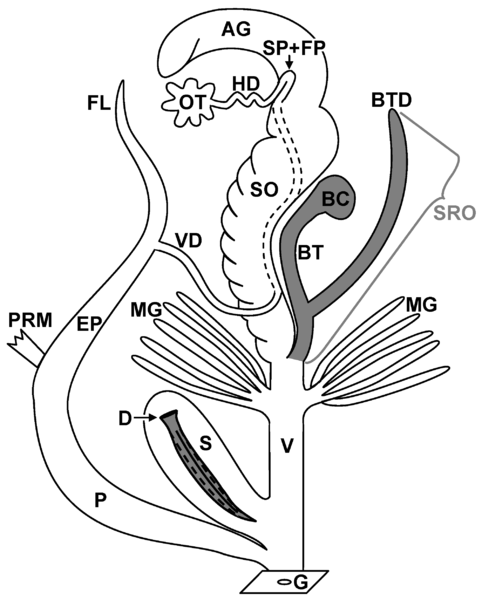Reproduction
The snail of
interest, Neohelix major, is a hermaphroditic species,
meaning that it possesses both male and female reproductive
anatomy (Cuezzo,
1990). As far as anatomical points of interest, Neohelix major possesses
male organs which include the penis, and vas deferens, while the
female organs consist of a vagina and a free ovary (Cuezzo,
1990). The reproductive system of Neohelix major also contains
the ovotestes and the hermaphroditic duct (Cuezzo,
1990). Because these organisms possess both male and female anatomy,
they are capable of performing cross fertilization which is the
fertilization of an organism by male and female gametes of the
same species (Hickman,
2012).Like other members of the Stylommatophora clade,
Neohelix major is able
to self fertilize in the case of severe isolation and still
produce fertile offspring
(Wilbur, 1984).
MG - mucus glands
P - penis
AG - albumen gland
HD - hermaphroditic duct
OT - ovotestis
SO - spermoviduct
VD - vas deferens
The reproductive
journey begins at the ovotestes, which is a hermaphroditic
reproductive organ containing tubes that house both male and
female gametes (Cuezzo,
1990). At around 13 weeks of life, when the individual is mature
sexually, the sperm moves from the tubules into the
hermaphroditic duct
(Cuezzo, 1990). Eggs from the albumen gland travel through the free ovary while
sperm travels out of the hermaphroditic duct and into the vas
deferens, where they run parallel to the eggs in the partially
segregated spermoviduct
(Cuezzo, 1990).
Just as in the other members of the Polygyridae family, when the fertilization occurs, it can be either internal or external (Emberton, 1993). Sperm can be deposited without the penis being inserted which results in either internal or external sperm exchange.
Fertilization occurs in snails of the Stylommatophora clade after a bout of courtship that then results in a fast transfer of sperm (Wilbur, 1984). When fertilization occurs in members of the Stylommatophora clade such as Neohelix major, the individual deposits eggs (Wilbur, 1984). To ensure that they have the highest survival rate possible, the eggs will most likely be laid in a damp place such as under a log or a moist area of brush and leaves (Wilbur, 1984). The most common reason eggs do not survive is due to drying out (Wilbur, 1984).
Terrestrial
gastropods have a direct life cycle, meaning that the eggs that
hatch do not have a larval stage, and emerge as juveniles that
are very similar to their adult counterparts (Hickman,
2012).
Continue on to see
our references and check out other great sources related to
Neohelix major.
